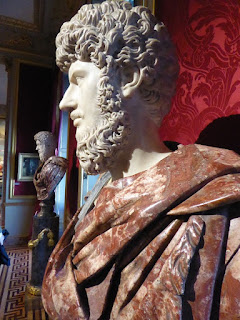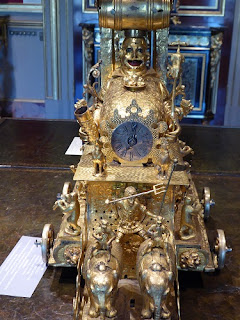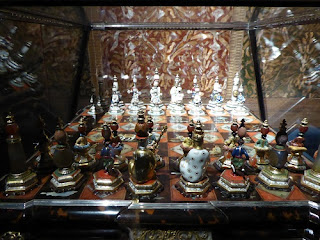From the Galerie J. Kugel, its astonishing collection lavishly housed in the 19th century Hôtel Collot, No. 25 Quai Anatole France,
to the Ministry of Foreign Affairs at No. 37 Quai d'Orsay
is only a few minutes' walk. But our privileged entrées to each building were separated by two days of packed activity - a leisurely hour or so on the Île Saint-Louis, supper with our friend Hélène just by Barbès - Rochechouart metro - a very different part of town - followed the next day by a major exhibition and the permanent collection at the Institut du Monde Arabe (with lunch on the roof), Snegurochka at the Paris Opera and my first inspection of the new Seine Musicale complex. So many impressions still to be digested - and at the very least I need to write up the Treasures of Islam in Africa and Picasso Primitif exhibitions (the latter we saw the day after our friend and host Laurence Auer was gonged at the Ministry).
Our tour of what has to be Paris's most spectacular private gallery - a house full of extraordinary, eccentric and valuable if not always beautiful art from the Renaissance through to the early 19th century - came courtesy of our friend Laura Kugel. We met her in the entrance hall - itself full of rich and curious furniture - and ascended the grand staircase around the above three graces clock, originally made for Charles IV of Spain and offered to Napoleon, who forced him to abdicate in 1808 and installed his brother Joseph on the Spanish throne.
On a nearby table sit two grotesque bronzes of a witch and a wizard.
The first room on the right upstairs has a series of paintings chiefly fascinating for the musical instruments pictured within.
Next door there's a gilded cage with singing birds, made by Swiss craftsmen for the Ottoman market in 1785.
We didn't get to hear the caged birds sing, but in the big rooms overlooking the Seine, several of the famous Renaissance automata made in Augsburg were up for demonstration. How I'd love to have seen the full exhibition of 31 pieces held here last year, of which this tantalising little film cleverly utilising Ketèlbey's In a Persian Market gives a neat taster.
There's also the most beautifully produced book on the subject, a copy of which I'm delighted to own.
Its superlative photographs notwithstanding, I'm still going to press ahead with a glimpse of some of the remaining items in context. Several, including perhaps the most beautiful, the elephant clock of c. 1580-90 illustrated on the cover pictured above, as well as the classy lion and his young African tamer, his stick rising and falling as part of the action, sit on a table
in front of two very handsome busts of Roman emperors.
The masterpiece of whimsy, though, is the clock-chariot of Bacchus,
a tankard of beer in his right hand and in his left a whole chicken and a skewered sausage, a barrel on his head,
being driven in his chariot by two elephants surmounted by pipe-playing satyrs and driven by a black coachman holding a trident.
As you see in the film, when activated Bacchus - also described as Hans Wurst or Gambrinus - rolls his eyes and the bear musicians around the base play instruments.
Further bizarre wonders unfold in other rooms and on other floors. The cabinet of curiosities is too rich to catalogue, but here are a few more favourites - a chess-set with Chinese figures,
and miniature depictions of Abraham poised to slay Isaac
and Jonah emerging from the whale's mouth.
Up another flight of stairs, early 19th century treasures have an appropriately more restrained setting
and as we drank coffee with Laura in her father's office, my eye was drawn to this very splendid backgammon set.
The afternoon sun shone against a cold wind in our subsequent promenade along the Seine, though folk found plenty of shelter along the embankment,
on the Île Saint-Louis
and on a section of the Rive Droite
with a bar in an old industrial building adding to the general liveliness. Via that walk we headed back towards the Cité metro for the ride north to Hélène's place at about 7.
She and her husband Olivier have an apartment opposite the splendid Louxor Cinema, opened in 1921, and brought back to new life in 2013 after years of dereliction.
It continued to glow in the last of the evening sun as seen from one of the apartment windows.
Hélène
had also invited the warm and delightful Maxime and Claude
and I have to say I enjoyed this evening of Bacchic mirth as much as anything during our stay.
Next morning, the election leaflets were out on Laurence's big table. I've done my best here to make sure the unspeakable is half-hidden.
Laurence and Bertrand have a place in the 15th arrondissement, very bourgeois compared to Barbès - Rochechouart as Hélène observed with amused brio: I'm sure she would be happy, as I am, to be defined as Bo[hemien]Bo[ourgeois]. They may not have the Louxor opposite but the view is typically Parisian.
That morning saw us flung to the four quarters of Paris, I to the Seine Musicale to interview Laurence Equilbey a second time (here, for reference's sake, is the interview from last year). This was my first glimpse of the new concert hall as I walked towards it from the Pont de Sèvres station at the south-west end of metro line 9.
Here it is from one of the two bridges connecting the Île Seguin across the Seine
and from the other.
Later in the day we all regathered at the apartment to change for the big ceremony. Which despite the opulent surroundings was very relaxed and genial. Harlem Desir, Secretary of State in charge of European Affairs, spoke eloquently of Laurence's achievements before she took the microphone. She really is the most extraordinary person - genuinely warm and natural, yet working at the highest level, most recently as French Ambassador to Macedonia and currently as Deputy Director for (France's part in negotiations re the) European Union.
Here she is with the medal, the Order of Merit; she already has the two categories of the Legion d'Honneur. Shame J had to be cropped out of a super pic as he rejects full-frontals here.
Bertrand was official photographer, though I got some different shots as I was on the other side of the room.
Later we were given a glimpse of the holiest of holies: the deco bath
in the bathroom specially installed for George VI and the consort we always knew as the Queen Mum.
On the ground floor - here's a shot from halfway down the grand escalier -
a wry and immensely likable Major Domo ('left and right, they all went to the same schools') showed us round the grander rooms, including the one in the second-to-top picture where Jean Monnet and Robert Schuman signed the momentous Schuman Declaration on 9 May 1950 which has ensured peace in much of Europe for the past 52 years. Again, the other proud EU representative had to be cropped out of this pic of a pic.
There were other lively ceremonies just finishing downstairs, so we shared this grand council chamber with others delighted at their various ennoblings.
Then we took a short walk over the newly-restored Pont Alexandre III with its Art Nouveau river gods on the balmiest and most beautiful of April evenings
to a supper at a destination I won't disclose since it's a private club and I shouldn't have taken any indoor pics, but may be excused this one, surreptitiously snapped sans flash at the supper table with a Gobelin tapestry of an episode from Don Quixote (seen a whole set at Belvoir Castle).
It commemorates an evening meal of such deliciousness that even our spoilt French friends said they couldn't remember anything like it in years. London clubs have so much catching up to do... And so, one final interior, Bertrand driving us home at the point when the Eiffel Tower does its midnight twinkly thing. The magical side of Paris did not elude us on this visit.

















































7 comments:
WOW ! But the London clubs will never catch up since the English ( or 95% of them) are not very interested in food, even the brilliant and the rich members of the smartest London clubs
Our thoughts exactly. Maybe in a few decades' time, if such clubs still exist, the greater interest in food among the younger generations will start to make a difference. Paris is, of course, exceptional (even if it's possible to eat badly there - see Jay Rayner's famous recent review of Le Cinq: https://www.theguardian.com/lifeandstyle/2017/apr/09/le-cinq-paris-restaurant-review-jay-rayner).
This points to a situation seen more often in London - places that can cook often don't bother to be consistent as the customers won't notice. Having been critical of London club food, I have to add a qualification. The worst club food used to be the Athenaeum, and the second worst the Carlton. Now the Carlton is better and the Atheneaum much better, though whether the members will notice is another matter As for the younger generation, how many palates ( in France as well as here) have been ruined by cheap and cheerful ( therefore attractive to the young) fast food , and by the trend towards grazing
Probably not the same palates that have the dosh to join a club. Though I notice the food's pretty crap in trendy, 'younger' clubs like Soho House.
Le sigh!
Pas d'envie, j'espere? C'est beau, non?
In Paris I would recommend le Voltaire for old time nostalgia the egg mayonnaise at 99 cents and the best pavees with frites, purée de pomes de terre et purée de celeriac.
Yes, [club name redacted] is magic, especially at a Sunday lunch time after mass at [church name redacted]. It's as good as having one's own house in Paris. The sun shining on the gold gilt. La carte de vin is superb and so very reasonable.
Post a Comment